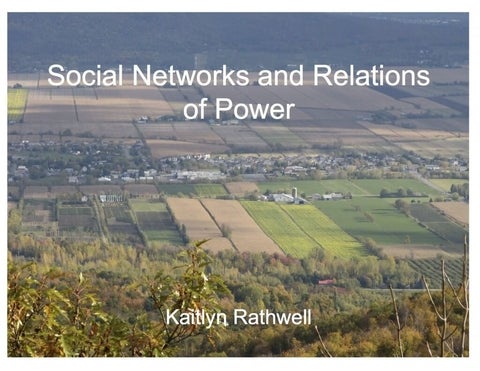A few weeks ago I had the pleasure of giving a talk to a group of graduate students in a course on ‘Sustainability Applications’ taught by Dr. Derek Armitage in Environment and Resource Studies here @ the University of Waterloo. I drew on my research experience in Quebec and New Brunswick, Canada to discuss embedding social networks in an ecological context and what a social network perspective can and cannot tell us about power. By clicking on the title slide below you can link to the full presentation on slideshare.
My presentation can be distilled into three main take away themes.
1. First, my research explicitly embeds social networks in their ecological context. Embedding social networks in this way can be helpful for both researchers and practitioners. A linked social-ecological perspective provides a novel methodological approach for addressing questions of (mis)fit and understanding the capacity social networks provide for navigating ecological change. Visualizations of ecological landscapes overlaid with social networks make tangible the complexity and relationships of a social-ecological system. For example, in my research with Dr. Garry Peterson recently published in Ecology and Society, we combined the social network for management of water quality with the distribution of different ecosystem services throughout the watershed. This social-ecological approach allowed us and our partners to visualize how the ecological management network related to the ecosystems being managed.
2. Second, using Lukes (2005) (PDF) conceptualization of the three dimensions of power (Decision Making Power, Non-decision Making Power, Ideological Power), I discussed how a social network approach might shed light on power. For example, the structure of a social network (e.g., decision making network) can provide insight about who holds central decision making authority. Such networks can also provide insight about non-decision making power because some groups can be left out of networks or poorly connected – possibly meaning they don’t have a voice in the decision making network. In the context of my research in Quebec, agriculturally-based municipalities are significantly less connected to decision-making networks about water quality. The disconnection of agricultural municipalities has direct implications for water quality in the region because agricultural municipalities contribute most to water quality degradation. As another example, in research I conducted in New Brunswick, Canada, it became very evident that the social network for water management is extremely centralized with all decision making authority at the center and watershed organizations acting as the link between local scale initiatives and the government of New Brunswick.
I discussed two limits to a social network perspective on power. First, ideological power is difficult to study because it is often hidden power. A social network perspective is a structural perspective and does not reflect ideological power. Secondly, social network mapping is a ‘snapshot’ in time and as such, the context in which the network exists can be left out. For example, norms and discursive customs are not evident from a network perspective. In my research I try to address these limitations by a) embedding the social network within its ecological context (not the whole picture, but a start) and, b) discussion of the social-cultural context from which the network is derived.
3. Finally, and perhaps most interestingly, I discussed social network visualizations as boundary objects that can help practitioners to reflect upon how they (or their organization) fit into a larger governance structure. In the New Brunswick research case, when I presented a visualization of the water governance network to practitioners (i.e., watershed organizations) they were able to reflect on the structure they are embedded within. They noticed their important role for bridging the local scale with the provincial scale when it came to decision-making about water and the very top down (centralized) structure of decision making for water in the province. Seeing a visualization of the governance network they were a part of helped these practitioners understand how they may use their individual and collective agency to manipulate the water governance network to become less centralized. This gets at some interesting ideas about the interplay of structure and agency in a natural resource management context.
Citations from the two research projects I drew on are as follows:
Rathwell, K. J. & Peterson, G. D. (2012). Connecting Social Networks with Ecosystem Services for Watershed Governance: a Social-Ecological Network Perspective Highlights the Critical Role of Bridging Organizations. Ecology and Society. 17(2): 24. [online] URL: http://dx.doi.org/10.5751/ES-04810-170224
Rathwell, K. and Plummer, R. (2012). Exploring the roles of Social Networks for Water Governance in New Brunswick, Canada: Lessons from the Water Classification Policy Initiative. Brock University: St. Catharines, ON.
